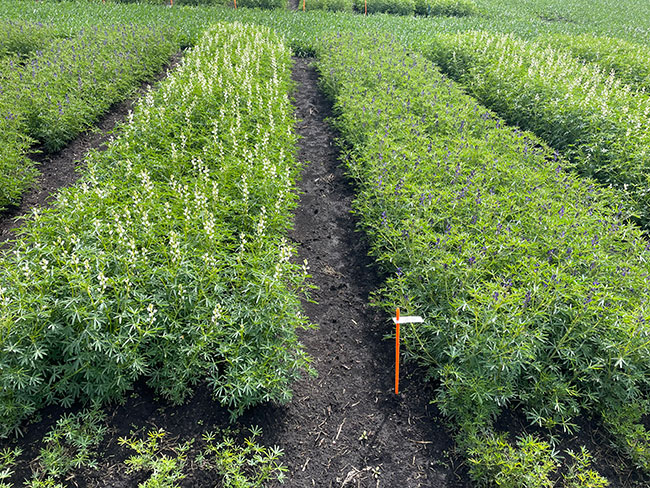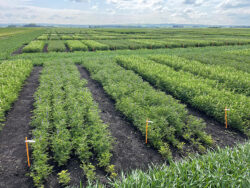
Features
Pulses
A new pulse crop for protein markets
Agronomic studies and variety trials are part of a comprehensive effort to capture lupin’s potential to become a profitable Prairie crop.
August 16, 2023 By Carolyn King
 Lupins, a high protein, cool-season crop, have the potential to be another pulse crop option for Prairie farmers.
Photo courtesy of Robyne Davidson, Lakeland College.
Lupins, a high protein, cool-season crop, have the potential to be another pulse crop option for Prairie farmers.
Photo courtesy of Robyne Davidson, Lakeland College. Lupin has been an important crop for years in places like Australia and Europe. But interest in growing this pulse crop in Alberta has waxed and waned. Now, with the rising market interest in plant-based protein, lupin may finally be finding its place in the sun in Alberta and the rest of the Prairies.
“Lupins are really high in protein compared to field peas, faba beans and lentils. Soybeans and lupins have a very similar protein percent, and in Europe, they are looking at using lupins in place of soybeans in anything that they do with soybeans,” notes Robyne Davidson, a pulse research scientist based in Lacombe, Alta.
“I think the potential for commercial production of lupin in Alberta is very high. If you compare the growing conditions in Europe to the Calgary-Edmonton corridor in Alberta, we have the same latitude, same day lengths and similar temperatures. Lupin is a huge crop over there. There is no reason why it can’t be a huge crop here too.”
Fresh optimism
In Alberta, lupins sparked the interest of researchers, agronomists and others about two decades ago. Those efforts, led mainly by Alberta Agriculture and Irrigation, determined that lupins, a cool-season crop requiring about 10 inches of rain, could be grown in Alberta. Although the researchers identified some production issues, the biggest obstacle to commercial lupin production at the time was market development.
“So, we put lupins on the backburner. Interest in lupins emerged again around 2010 and in 2017. Each time, we studied them a little more and then put them on the backburner,” explains Davidson, who transitioned from Alberta Agriculture and Irrigation to Lakeland College in 2021.
“Then a few years ago, some countries became very interested in finding protein substitutes because of the increasing consumer interest in plant-based foods. And Tristan Choi [CEO of Lupin Platform Inc.] and some of the people he was in business with decided to put some money behind commercializing lupin [in Canada].”
“We’re cautiously optimistic about the opportunities for lupins to develop into a profitable crop choice for growers at least in certain areas of Alberta,” says Shane Strydhorst, chair of Alberta Pulse Growers (APG).
“This time around there are companies such as Lupin Platform Inc. that have clear plans and demand for lupins both as seed and as processed ingredients in food production. And we’re working on developing some management strategies so farmers can be equipped with the knowledge to successfully grow and harvest a profitable lupin crop in Alberta. Also, there are newer varieties that are much better than those available 20 years ago, and we’re looking at the adaptability of these varieties in various locations in the province right now.”
He notes, “Lupins would add another pulse crop option for farmers in Alberta. That is becoming increasingly important as many of our farmers who appreciate the nitrogen fixing and rotational benefits of peas or lentils are struggling with significant disease issues like Aphanomyces root rot.
“Faba beans are not susceptible to Aphanomyces and they are an excellent alternative in regions with enough rainfall. We’re hoping that lupins, which are also not susceptible to this root rot, will provide a good option where faba beans aren’t suitable.
Strydhorst and Davidson would both like to see a careful roll-out of lupin production. “To ensure success, we have to have a careful strategy so we don’t overwhelm a small market. We have to grow demand hand-in-hand with supply,” says Strydhorst.
Davidson’s agronomic and variety trials
Davidson is currently leading a project to work on some of those remaining lupin production issues. This three-year project, which started in 2021, is funded by APG and Results Driven Agriculture Research.

Davidson’s lupin research in Alberta includes blue and white lupin variety trials, as well as agronomic trials.
Photo courtesy of Robyne Davidson, Lakeland College.
In the project’s trials at Lacombe and Edmonton, Davidson and her research group are investigating herbicide options, disease and insect issues and preharvest dry-down practices. As well, they are conducting variety trials at Vermilion and Barrhead.
They are working with narrow-leaf blue lupin (Lupinus angustifolius) and white lupin (Lupinus albus). These two agricultural species are known as “sweet” lupins because breeding has greatly reduced the alkaloid levels in the seeds, so they are suitable for food and feed uses. Blue lupin is better suited to central Alberta conditions, and its seed size is similar to field peas. White lupin has larger seeds and later maturity, but the processing industry tends to prefer it.
In-crop herbicide options
When it comes to weeds, lupin production faces a double whammy: lupins are terrible competitors, and few herbicides are currently registered in Canada for use on lupins.
“Although grassy weeds are fairly easy to control, one of our biggest challenges is to control broadleaf weeds. At present, the only broadleaf herbicide registered for use on lupins is metribuzin, also known as Sencor or Squadron,” says Davidson.
“In our project, we’re bringing in products from countries like Australia and screening them, and if we have any success, using the data to see if we can get some minor use registrations put forward.
“For instance, we’re trying to find products that we can apply before planting that have a bit of residual that will control the weeds but not kill the lupins. We are also trying products in-crop at smaller stages and then maybe at slightly later stages.”
Based on research so far, Davidson advises lupin growers to apply Edge (ethalfluralin) in the fall, and then in the spring just before or just after seeding lupins, apply Roundup (glyphosate) so the lupins start off with the cleanest field possible.
Also, don’t seed lupins on Roundup Ready canola stubble because, of course, the volunteers won’t be killed by Roundup. “The volunteer Roundup Ready canola usually comes up ahead of the lupins. By the time we get to the proper growth stage when we can spray the very limited broadleaf herbicides that we have, the canola is too far gone and doesn’t respond. So, you have a field of canola with some lupins in it.”
No major disease or insect issues
Although lupins are susceptible to some root rots and anthracnose has potential to cause problems in certain white varieties, disease issues in Davidson’s plots have been fairly limited to date.
Her group has tested five or six seed treatments and in-crop fungicides from different fungicide groups. There hasn’t been any response to any of the products so far, which is not unexpected given the low disease levels.
Davidson is also working on a small study with Agriculture and Agri-Food Canada (AAFC) in Lethbridge to confirm lupin’s resistance to Aphanomyces. She explains, “Lupin so far has been shown to be resistant to Aphanomyces, which has everybody quite excited. However, it is one thing to show that in other countries and in lab or greenhouse studies, but is lupin actually resistant to Aphanomyces in the field here?”
Her group is also monitoring the lupin plots for insect problems. “So far, blister beetles are the only insects that are giving us any concerns at all, although I suspect other bugs will probably start finding lupins and like them,” she says.
Although blister beetles tend not to be a serious concern for most crop types in most years, these beetles love lupins. “When they find our lupin plots, blister beetles will decimate them in three days, with just leafless sticks remaining.”
Dry-down questions
The project’s dry-down trials are looking at Reglone (diquat), Roundup and Heat (saflufenacil). Davidson and her group want to find out which product works best with lupins, what is the best time to apply it and when is the best time to go in with a combine after applying the product.
“For most pulse crops, I don’t recommend spraying Roundup to help dry the crop down. You’ll kill your germ and it will take too long for them to dry down. By far, Reglone is the superior product,” she explains.
“But lupins have very woody, thick stems, so perhaps we might want to come in a little earlier to desiccate lupins. And Reglone is not very good at drying down stems. So, which product is best for lupins and when should we use it, when is too early and when is too late?”
Also, the timing of combining for lupins can be tricky because of the risk of severe pod shattering, depending on the conditions. “With peas, faba beans, lentils and most other pulse crops, you spray them and wait for them to dry-down; you might even wait a few extra days to make sure they are nice and dry,” she explains.
“With lupins, if you wait and you don’t keep an eye on them, you may come back a couple of days later to find a third of your seeds all over the ground. And sometimes if the pods are too dry, when you come in and hit them with the combine header, the pods just explode. The lupins go everywhere except on the belt and into the combine.”
Variety trials
At present, all the lupin varieties in Davidson’s trials are European. “Right now, there is no focused attention on breeding lupins in Canada. Given the similar growing conditions, we have had the most success with European varieties. I recently made some new contacts in Europe, so I will be bringing in other European varieties,” she notes.
“The growing conditions in Australia’s lupin production area are very different, and the Australian varieties that we tried years ago didn’t do well here. However, we’re going to give some of their recent varieties a try.”
The varieties in these trials change from year to year, as she swaps out poorly performing ones and tries new varieties. Going forward, she is mainly focusing on three blues and three whites.
Next steps and other studies
Alberta weather over the past three years has created challenges for Davidson’s project. For example, very dry conditions in some years have made it difficult to fully assess certain disease risks and to evaluate dry-down products and practices.
After this project is completed, she is hoping to continue working on lupin agronomics to build on what has been learned so far.
Along with Davidson’s project, APG is currently funding a study led by AAFC research scientist Breanne Tidemann to evaluate herbicide options for lupins. Also, lupins are a minor piece in some APG-funded protein and starch projects.
As well, Lupin Platform Inc. (LPI) is leading agronomic and variety trials in Alberta and across Canada – plus a lot of other research and development work – as part of developing an integrated lupin value chain in Canada.
Seed-to-fork’ value chain
About four and a half years ago, several companies with different areas of expertise joined forces and started working on various components of a Canadian lupin value chain. LPI, a Calgary-based company, was created in 2021 to lead development of the value chain.

Lupin’s high protein content opens up opportunities for value-added processing to create plant-based food products. Photo courtesy of Lupin Platform Inc.
“The reason we picked lupin is we were looking for another nitrogen-fixing crop that is new to North America, and because of the unique characteristics of lupin’s nutritional composition as well as the benefits to the farmers,” explains LPI’s Tristan Choi.
“Over our first four-and-a-half years, we have created a complete ‘ecosystem’ for lupin supply chain development from seed licensing, to farm production, to ingredient processing, to product development,” he says. “We now have 11 food prototypes that we are hoping to launch in the next 24 months.”
These prototypes include products like non-dairy milk and ice cream alternatives, egg substitutes and a baking mix.
While LPI is working to grow the demand for its lupin food products, it is also developing feed uses. For instance, it currently has a dairy cattle feeding trial that is nearing completion. Choi notes, “Given that lupin has long been used in Europe, Australia and Asia for animal feed, we are very confident that lupin has its own place in the animal feed market in Canada.”
LPI, in collaboration with pulse agronomists, is working on various activities to advance the crop production portion of the value chain.
“We have several lupin varieties with an exclusive distribution licence for Canada. And every year we test new varieties to see if they are adaptable to Canadian conditions,” he says.
The variety trials are taking place at multiple sites in Alberta, Saskatchewan and Manitoba as well as in Quebec and Prince Edward Island. Also at these sites, LPI is conducting agronomic studies such as herbicide and seeding rate trials.
LPI is gradually increasing its contracted lupin acres. “This year we have 780 acres, but we are looking to expand that to 2,000 to 3,000 by next year,” notes Choi.
According to Choi, lupin’s resistance to Aphanomyces is getting the attention of potential growers. “We are giving farmers a new choice for a different nitrogen-fixing crop in their rotations. So, instead of having to convince farmers to grow lupins, the farmers are now coming to us.”
He explains that creating the lupin value chain has been very capital intensive, especially the R&D to develop novel lupin ingredients and food formulations. Federal support through such programs as the National Research Council’s Industrial Research Assistance Program and Protein Industries Canada’s co-investment helped expand this R&D work.
“Building this entire ecosystem was quite challenging in the beginning because of the economic conditions, COVID, supply chain issues and commodity prices going through the roof. And of course, starting to introduce and establish a new crop – a crop that is beneficial not only economically and environmentally but also socially in many aspects – is challenging,” says Choi.
“But it has been a collective effort through [federal funding support] and some of the professional people who really want to see lupin grown in Canada. We believe the future is very bright, given the benefits we can capture together. In the next two to four years, it is going to be a very exciting ride.”


